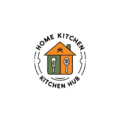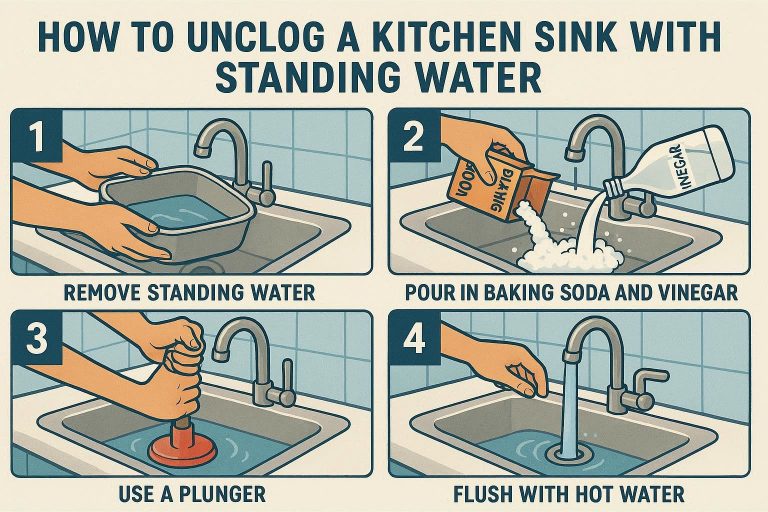A clogged kitchen sink with standing water is more than just a minor inconvenience—it’s an urgent issue that needs to be addressed quickly. If left untreated, standing water can lead to unpleasant odours, create a mess, and even attract pests. Whether it’s a slow drain or water that refuses to go down, it’s crucial to tackle the problem as soon as possible to avoid bigger issues down the line.
In this article, we’ll discuss several effective ways to unclog your kitchen sink. From quick, simple fixes to more advanced methods, you’ll have plenty of options to get that sink flowing again.
Understanding the Causes of Standing Water in Your Kitchen Sink
Before diving into the solutions, it’s essential to understand what causes a sink to become clogged in the first place. Knowing the root of the problem can help you choose the right method for unclogging and also guide you in preventing future blockages.
Common Reasons for Clogged Kitchen Sinks
1. Food Debris and Grease Buildup:
Kitchen sinks are notorious for collecting food particles and grease. Every time you wash dishes or rinse food scraps Cleaning Guide for Home & Kitchen down the drain, bits of food can accumulate in the pipes. Grease from cooking, especially oils and fats, can solidify and build up over time, restricting the flow of water.
2. Soap Scum and Mineral Deposits:
If you live in an area with hard water, mineral buildup can occur in the pipes, leading to a slow drain. Soap scum can also contribute to this problem, as it sticks to the walls of the pipes and traps debris.
3. Foreign Objects Trapped in the Drain:
Sometimes, an accidental slip can send small objects, such as a fruit pit, bottle cap, or even a piece of silverware, into the drain. These objects can become lodged in the pipes and block the flow of water.
How Standing Water Forms
1. Blockage in the Drain or Pipes:
Most often, standing water is a result of a blockage somewhere along the drain or pipes. This prevents the water from flowing freely, causing it to back up into the sink. The clog could be caused by food waste, grease, soap scum, or any combination of these.
2. Drain Traps and Their Role in Clogging:
The P-trap, the curved pipe under your sink, is designed to catch debris and prevent unpleasant odors from rising into your kitchen. However, when too much debris accumulates, the trap itself can become clogged, causing water to back up into the sink.
When to Call a Professional vs. DIY Solutions
If you’ve tried a few DIY methods without success, or if your sink continues to clog despite your efforts, it may be time to call in a professional plumber. This is especially important if the clog is deep in the pipes, or if you notice signs of a more severe problem, such as foul smells or recurring blockages. A plumber can diagnose the issue and use advanced tools to clear the clog safely.

Simple Methods to Unclog Your Kitchen Sink
Before calling a plumber, it’s worth trying a few simple methods to clear the blockage. These solutions are easy, cost-effective, and often effective in addressing minor clogs.
Method 1: Boiling Water
Boiling water can be one of the simplest and most effective ways to clear a kitchen sink clog. This method works best if the clog is caused by grease, soap scum, or small food particles.
How and Why Boiling Water Works:
Boiling water helps break down the grease and food debris, dissolving them so they can flow freely through the pipes. The hot water also helps to melt any fat-based blockages, allowing the water to pass through more easily.
Step-by-Step Instructions:
- Boil a large pot of water (about 4-6 cups).
- Carefully pour the hot water down the drain in two to three stages, allowing the water to sit for a few seconds between each pour.
- Let the water sit for about 10 minutes, then check to see if the standing water has cleared. If not, repeat the process.
Method 2: Using a Plunger
A plunger is one of the most common and effective tools for unclogging a kitchen sink. The force generated by the plunger can help dislodge the debris causing the blockage.
Choosing the Right Plunger for a Kitchen Sink:
For kitchen sinks, a cup plunger (flat-bottomed) is the best option. If you have a double sink, you may need to seal one side of the drain with a wet cloth to create enough suction on the other side.
Effective Plunging Techniques:
- Place the plunger over the drain and ensure a tight seal.
- Push down firmly, then pull up quickly to create suction.
- Repeat this motion 10-15 times, ensuring a strong seal is maintained throughout.
- After plunging, check the sink to see if the water drains properly. Run some hot water to help clear any remaining debris.
Method 3: Baking Soda and Vinegar
This natural solution is a great way to tackle minor clogs and eliminate odors. The chemical reaction between baking soda and vinegar can help break down the clog and clean the pipes.
The Chemical Reaction:
When baking soda (a base) meets vinegar (an acid), they create a fizzing action that loosens debris and dislodges blockages. This method also deodorises your sink, leaving it with a fresh scent.
How to Use Baking Soda and Vinegar:
- Pour 1/2 cup of baking soda into the drain.
- Follow it with 1/2 cup of white vinegar.
- Cover the drain with a cloth or plug to contain the fizzing action.
- Let the mixture sit for about 30 minutes, then flush the drain with hot water to clear any remaining residue.
Advanced Methods to Clear a Clogged Sink
If the basic methods don’t work, or if you have a persistent clog, you may need to resort to more advanced techniques. These methods are beneficial for addressing deeper or more stubborn blockages.
Method 4: Using a Plumbing Snake
A plumbing snake is a long, flexible tool designed to break through or retrieve clogs further down the drain.
What is a Plumbing Snake and How It Works:
A plumbing snake is a coiled metal cable that can be inserted into a drain. By rotating the snake, you can either break up the clog or hook it and pull it out.
Step-by-Step Instructions:
- Insert the snake into the drain opening and rotate it clockwise to move it into the pipe.
- Continue pushing until you feel resistance (this is likely the clog).
- Rotate and push the snake to break up the clog or pull it out.
- Once the clog is clear, flush the drain with hot water to ensure it’s fully cleaned.
Method 5: Disassembling the P-trap
The P-trap, the curved pipe under your sink, often collects debris and causes clogs. If other methods haven’t worked, it may be time to disassemble the P-trap and clean it manually.
How to Remove and Clean the P-trap:
- Place a bucket or large bowl under the P-trap to catch any water or debris.
- Use a pipe wrench or adjustable pliers to loosen the nuts holding the P-trap in place.
- Carefully remove the P-trap and inspect it for any debris or clogs.
- Clean the P-trap with a brush or a small tool to remove buildup.
- Reassemble the P-trap and check if the water drains properly.
Method 6: Using a Wet/Dry Vacuum
A wet/dry vacuum can be a powerful tool for removing stubborn clogs, especially if they are located near the surface of the drain.
When to Use a Wet/Dry Vacuum:
A wet/dry vacuum is ideal for clearing out debris near the drain opening, but it can also be useful for extracting water from a sink that’s filled with standing water.
Safety Precautions:
- Ensure the vacuum is set to suck up liquids.
- Seal the vacuum hose tightly around the drain to maximize suction.
- Make sure to wear gloves and avoid direct contact with the vacuum hose.
Prevention Tips to Avoid Future Clogs
Once you’ve unclogged your sink, it’s essential to take steps to prevent future blockages. Regular maintenance can go a long way in keeping your pipes clean and your sink draining smoothly.
Regular Cleaning and Maintenance
A little prevention can save you from big headaches. Make it a habit to clean your sink drain regularly. Pour boiling water down the drain once a month, or use a mixture of baking soda and vinegar to clean the pipes.
Avoiding Grease and Food Debris
One of the best ways to prevent clogs is to avoid putting grease, oil, or food scraps down the sink. Instead, dispose of grease in a separate container, and use a garbage disposal for food waste (but don’t overload it!).
Investing in Drain Guards
Drain guards or strainers are inexpensive tools that can catch food debris before it enters your pipes. They’re easy to clean and can help prevent a lot of clogs from forming.

Troubleshooting: When DIY Methods Don’t Work
Sometimes, despite your best efforts, your sink might continue to clog. Here’s how to troubleshoot when your DIY methods don’t work.
Identifying When You Need Professional Help
If your sink repeatedly clogs, or if you notice foul odors, slow drainage, or water backing up into other parts of your home, it may indicate a deeper plumbing issue. In this case, it’s best to call a professional plumber.
How a Plumber Can Help
Plumbers have specialized tools like hydro-jetting and camera inspections to identify and clear tough blockages. They can also identify issues like tree root intrusion or problems with your main sewer line.
Costs of Professional Plumbing Services
The cost of professional plumbing services can vary depending on the location and the severity of the issue. Typically, drain cleaning services range from $150 to $300. If you require major repairs, the costs can increase significantly.
FAQ
Why is there standing water in my kitchen sink?
Standing water usually indicates a blockage in the drain pipes, often caused by grease, food particles, or foreign objects.
Can I use a plunger on a double kitchen sink?
Yes, but you may need to seal one side of the sink to create enough pressure on the other side when plunging.
Is it safe to use chemical drain cleaners on kitchen sinks?
While chemical drain cleaners can work, they can also damage pipes and harm the environment. It’s best to try natural methods first.
How often should I clean my kitchen sink drain?
Regular maintenance, like flushing with boiling water or using a natural cleaning solution, can help prevent clogs. Cleaning once a month is ideal.
What should I do if the water keeps backing up after unclogging the sink?
Persistent backups may indicate a more serious problem with your plumbing. In this case, it is recommended to call a professional plumber.
Conclusion
A clogged kitchen sink with standing water can be frustrating, but with the right methods, you can tackle it head-on. From simple fixes like boiling water and plunging to more advanced techniques like using a plumbing snake, you have plenty of options to restore your sink to its proper function.
Take preventive measures to avoid future clogs, and don’t hesitate to call a plumber if the issue persists. With a little effort, your kitchen sink will be clog-free in no time!
Have you tried any of these methods to unclog your kitchen sink? Share your experiences and tips in the comments below. And don’t forget to subscribe to our blog for more helpful home maintenance advice!

